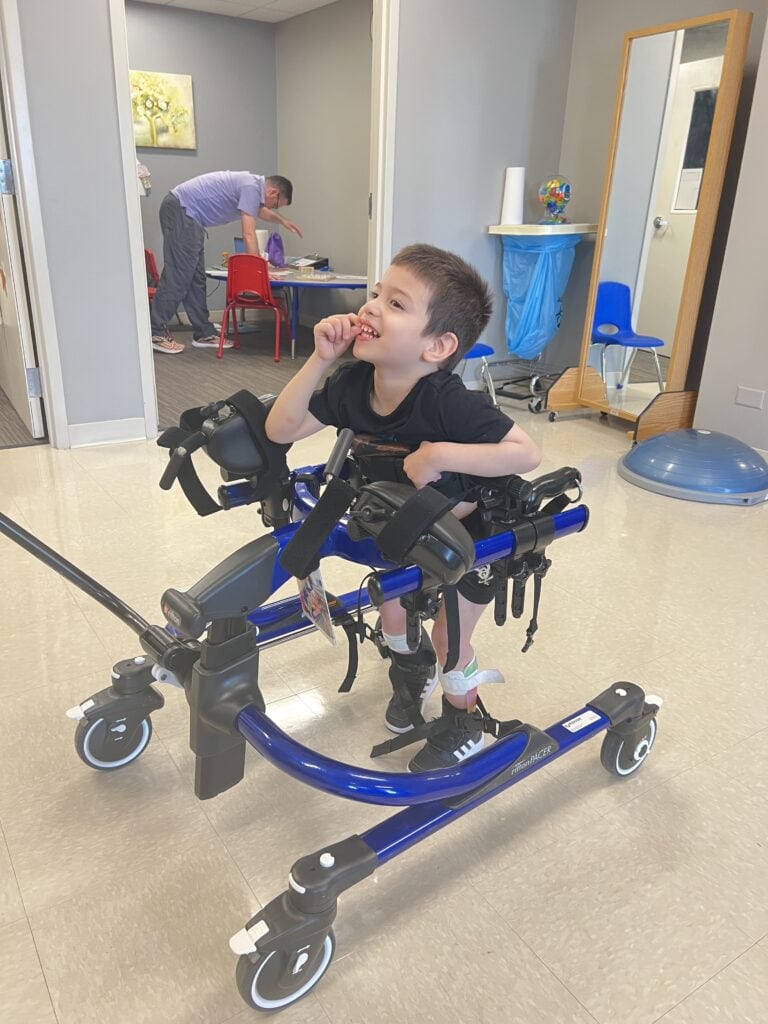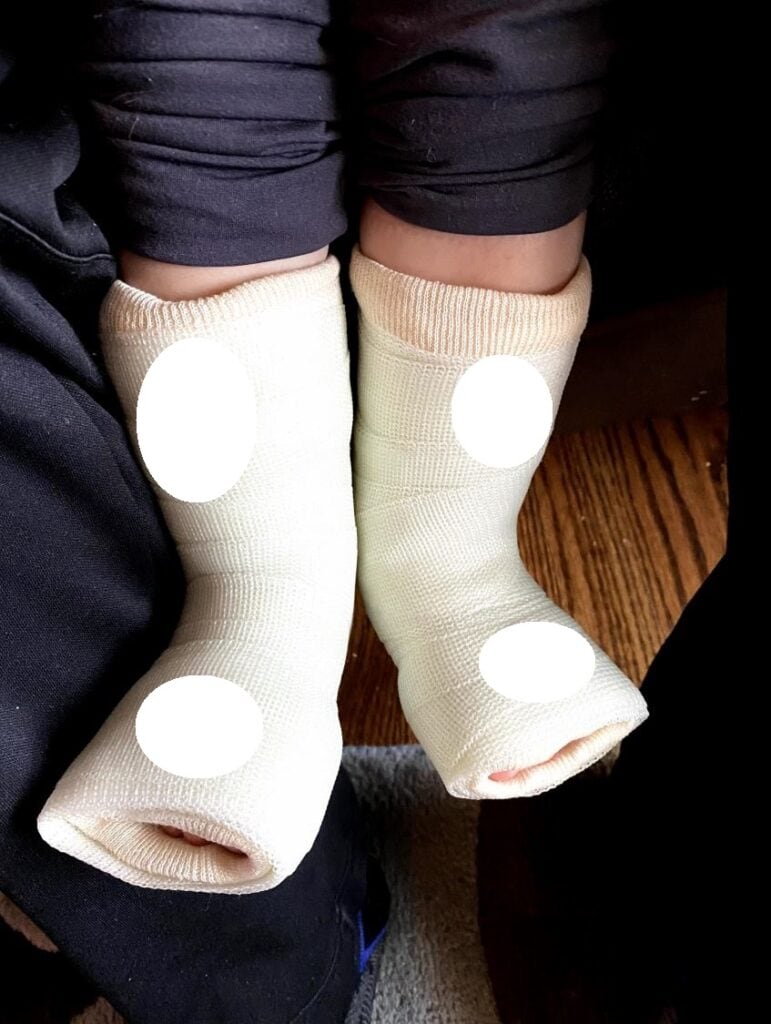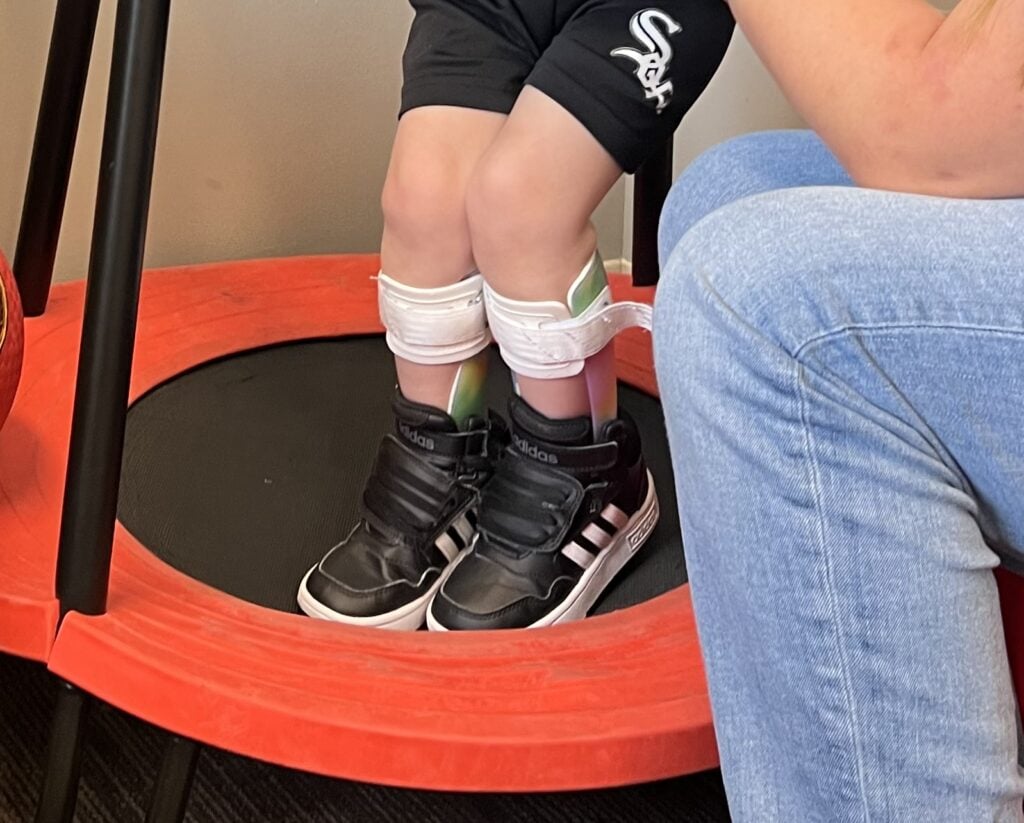Idiopathic Toe Walking
What is Idiopathic Toe Walking?
Idiopathic toe walking is when kids walk on their “tippy toes,” without touching the ground with their heels. The term “idiopathic” simply means that this type of walking has an unknown cause. When toddlers are still learning how to walk, toe walking isn’t an unusual phase to go through.¹ That said, if kiddos keep toe walking after a month or two on a regular basis or only utilize toe walking once they’ve worked out the pattern (viewed as time walking > crawling), we recommend an evaluation for pediatric therapy services.

Idiopathic toe walking (ITW) can be seen in about 5% of healthy children.² Toe walking has many known causes which include but are not limited to, cerebral palsy, muscular dystrophy, club foot, autism spectrum disorders, and some intellectual disabilities.¹ These underlying conditions give cause as to why a child may toe walk. With that understood, if a child continues toe walking and doesn’t have a condition similar to the above major diagnoses, a doctor may diagnose the child with ITW by ruling everything else out.
Possible Causes of Toe Walking in Children
The exact cause of ITW is unknown, but these are some reasons believed by researchers and therapists:
Muscle Tightness
Tight leg muscles can make it hard for a child to walk with a heel-to-toe pattern. Imagine a strong stretch in the back of your leg every time you take a step, one that was almost painful. You would probably change the way you walk, too, to avoid that pain. Muscles that could cause toe walking if they’re tight include the calf muscles, hamstrings (back of the thigh), and hip flexors (front of the hips).³
- Tight calf muscles can make it difficult to lift and keep the toes pointing upward while walking.
- Tight hamstrings limit the amount the knee can straighten as the leg swings forward to take a step. That then affects the position of the foot when it contacts the ground.
- Tight hip flexors can shift the child’s weight too far forward. This causes them to lean so far forward that they have to walk on their toes to keep their balance.
Decreased Stability
A child might toe walk to increase ankle stability they don’t have. This affects their ability to walk heel-to-toe. Weak core muscles, low muscle tone, and overly lax ligaments can all contribute to feeling unstable. When the ligaments in the feet/ankles are overly lax, they don’t help keep the foot in a stable position on the floor. Instead, the ankles would roll inward (‘excessively pronate,’ if we’re being fancy and using our big PT words). This makes it harder for the child to balance and develop arches in their feet. If a toddler doesn’t feel stable, for whatever reason, they may resort to walking on their toes which tightens the lax ligaments.
Sensory Seeking/Avoidance
Babies and younger kiddos are constantly exposed to new sensations. These include seeing friendly faces, tasting new foods, hearing water splashing, or smelling freshly baked cookies. Just like those sensations, they also learn how the carpet feels on their skin when they stand. They learn how the pressure of their weight feels through their feet and ankles.

Some kids who toe walk might really like the extra pressure in their joints when they walk on their toes, so they do it all the time. This would be called sensory seeking behavior.
Other kids might really dislike (or even the H word) the feeling of touch or pressure on their feet. They may walk on their toes so as little of their feet touch the floor as possible.⁴ This would be called sensory avoidance. Sometimes, they only avoid certain textures, like grass or carpet.
A child often toe walks because of sensory seeking or avoidance tendencies. They can show these behaviors in other routines. This looks like preferring certain textures of food or surfaces. This can also present as liking/disliking getting their hands dirty. They can seek or avoid this during meal time or play.
Use of Baby Jumpers/Walkers
When babies are in jumpers, they usually end up bouncing on their toes. Over time, their calf muscles could get tight from using them more than other muscles to jump up and down. Along the same lines, the habit to push off of their toes may get so strong that they can’t unlearn the bouncing. If they’re always on their toes, they may not like the feeling of stepping on their heels when they learn to walk.⁵
Baby walkers can also encourage toe walking and interfere with proper hip development. This is because kids can rely on the seat for support causing the muscles and joints develop in a way mother nature simply didn’t intend. Baby walkers can also distribute their weight through their feet in unnatural ways as well. In turn, this develops a mindset for them to avoid / limit using their muscles as they to try to walk.


Jumpers and walkers can definitely be a convenient way to keep a highly mobile infant safe and out of mischief, but it’s important to limit the amount of time they use them (or better yet, not even have them in the home). Other ways to keep your kiddo safe is to play on the floor (supervised, of course), use a crib or pack & play. You can also use a gated or a child-proofed room/area. These examples encourage proper motor and cognitive development!
Why is Toe Walking in Kids Undesirable
ITW does resolve in some children, but it can also continue long term if not addressed properly at an early age. Introducing therapy early can prevent problems later on. Potential long-term effects may include pain in the feet and ankles that can go up to the knees, hips, and low back. They can also experience shortening of calf muscles, causing limited ankle motion. Another long term effect is poor arch development (flat feet). Toe walking and its effects can lead to poor development of balance and coordination skills. This makes it hard for a child to safely keep up with their friends at school.⁴,⁵
How Does Pediatric Therapy Help Idiopathic Toe Walking
A pediatric physical therapy specialist can help figure out the most likely reason(s) your child is toe walking. Then, they develop a plan of care that includes stretches and exercises to help your kiddo. Some of the treatments that therapists will use are listed below. If these fail, other treatments may need to be considered. This includes Botox to weaken a tight calf muscle or surgical muscle lengthening.¹,⁷ Surgery is considered a last resort and is rarely necessary.
Strengthening
Therapists are trained to create play-based activities. This makes physical therapy fun for you and your kiddo. Every child is different, so therapists will choose the best exercises for your child. These will strengthen the muscles they need to walk on their heels.
Stretching
Therapists can also assess your child to find which muscles may be tight. Your therapist will also look for limited joint motion. Therapists then teach you how to safely stretch your kiddo’s muscles. When done correctly, even stretching can be disguised as play.
Casting
Serial casting is a process of applying and removing multiple padded casts to a joint. This is most commonly used for the ankle. The casting process takes up to a few months and is used to provide prolonged stretch to improve muscle length and ankle mobility.⁷ And yes, children can walk in the casts!

Orthotics
A therapist might recommend orthotics based on your child’s age and ankle motion. These ‘braces’ limit the amount of ankle motion a child has while walking.⁷ For example, if a child has ‘excessive pronation’, orthotics can support their ankles to help them walk heel-to-toe.
- There are two types of supramalleolar orthoses (SMOs), traditional and toe walking. They are less restrictive and have more dynamic control of the foot and ankle. This facilitates development of balance and coordination.⁴
- Toe walking SMOs are made specifically to prevent toe walking. These are recommended when a child has a strong habit to walk on their toes, and they have no muscle tightness.
- Ankle foot orthoses (AFOs) can be more effective in limiting ankle range of motion. These would be recommended if your child needs more ankle support than an SMO could give them.

A physical therapist and orthotist will work together to treat your child. They will consider the needs of your kiddo to figure out which option would be best.
Increasing Sensory Input
This treatment helps if a child toe walks because they crave or avoid sensory input. A pediatric occupational therapy specialist may be able to help provide your child with a “sensory diet”. A “sensory diet” is the use of different strategies to help give your child the amount of sensory input they crave. This can help your child perform their daily activities/routines. These strategies can include compressing their joints or weighted vests to give your child sensory input. They can also include controlled exposure to non-preferred activities. Treating a child’s sensory needs may lead to decreased toe walking.

Next Steps for Idiopathic Toe Walking Kids
I know this was a lot of information, so here’s a recap: ITW is likely nothing to worry about as your child first starts to stand with support and walk, but if it continues once a child is walking independently and your child is on their toes for most of the time, consider calling your pediatrician. You can ask them if it might be helpful to try physical and/or occupational therapy. ITW is a diagnosis made by a physician after ruling out other potential causes. A physical or occupational therapy specialist can help the family in treating the underlying causes of toe walking and preventing long-term effects. If you’re looking for some guidance, schedule an evaluation with Milestone Therapy to work with one of our awesome therapists! We’ve seen it before, we’ll see it again, and it’s our job to help you and your little one find your way!
Written by Vivian Chau, PT, DPT
References:
- Caserta AJ, Pacey V, Fahey MC, Gray K, Engelbert RHH, Williams CM. Interventions for idiopathic toe walking. Cochrane Database of Systematic Reviews 2019; 10(CD012363)
- Engström P, Tedroff K. The prevalence and course of idiopathic toe-walking in 5-year-old children. Pediatrics 2012;130(2):279-84.
- Oetgen ME, Peden S. Idiopathic Toe Walking. J Am Acad Orthop Surg 2012;20:292-300.
- Treating Pediatric Toe Walking – Is it Idiopathic? Megan Smith CO, Director of Clinical Research Surestep, South Bend IN. Presented at Association of Children’s Prosthetic-Orthotic Clinics Annual Meeting; March 22-25, 2017; Houston.
- Sanders A. Do Infant Jumpers Affect Child Development. Hello Motherhood, https://www.hellomotherhood.com/article/286964-development-infant-jumpers/ Published June 13, 2017. Accessed 4 June 2020.
- Le Cras S, Bouck J, Brausch S, Taylor-Haas A; Cincinnati Children’s Hospital Medical Center: Evidence-based clinical care guideline for Management of Idiopathic Toe Walking, http://www.cincinnatichildrens.org/service/j/andersoncenter/evidence-based-care/occupational-therapy-physicaltherapy/, Guideline 040, pages 1-17, February 15, 2011.
- Ruzbarsky JJ, Scher D, Dodwell E. Toe walking: causes, epidemiology, assessment, and treatment. Curr Opin Pediatr 2016;28:40-46.
